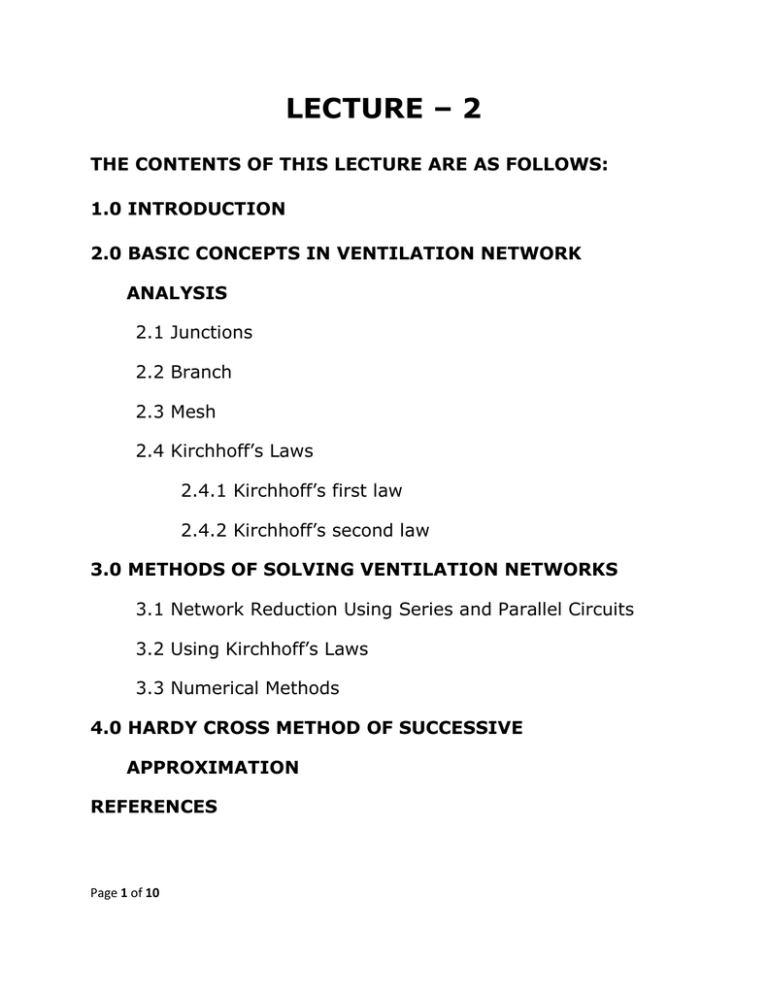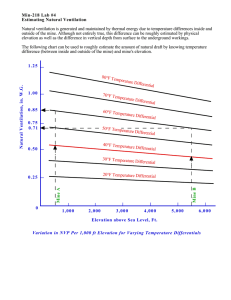lecture – 2
advertisement

LECTURE – 2 THE CONTENTS OF THIS LECTURE ARE AS FOLLOWS: 1.0 INTRODUCTION 2.0 BASIC CONCEPTS IN VENTILATION NETWORK ANALYSIS 2.1 Junctions 2.2 Branch 2.3 Mesh 2.4 Kirchhoff’s Laws 2.4.1 Kirchhoff’s first law 2.4.2 Kirchhoff’s second law 3.0 METHODS OF SOLVING VENTILATION NETWORKS 3.1 Network Reduction Using Series and Parallel Circuits 3.2 Using Kirchhoff’s Laws 3.3 Numerical Methods 4.0 HARDY CROSS METHOD OF SUCCESSIVE APPROXIMATION REFERENCES Page 1 of 10 1.0 INTRODUCTION An underground mine consists of a complex network of roadways in various districts, in case of a coal mine and an extensive network of levels in case of metal mines. For proper and efficient functioning of the mine, it is required to constantly monitor the ventilation status in each roadway leading to a particular district or panel. Ventilation surveys must be carried out from time to time and various parameters of the roadway must be recorded for future ventilation planning and/or for modifications in the current setting. The ventilation system of a mine is a dynamic entity, with different elements being added to or removed from it every day. Thus, ventilation planning is a continuous process. It is always desirable to predict and plan ahead for the future so that various equipments like fans are made available for modifying the ventilation network without having to halt the mine’s production. While ventilation surveys are done locally in a particular roadway, a network analysis is done for the complete network of interconnected roadways. A ventilation network analysis tries to tackle and solve the following problems: o To explore the possibility of quantitatively predicting the airflow in different roadways when the resistance of the roadways and the spatial interconnection of them are known. o To estimate the capacity and combination of fans based on the ventilation network to generate a given airflow quantity. Prior to the introduction of systematic algorithms for solving ventilation networks, the ventilation engineers used to design the networks based on their assumptions, experience and intuition. This would yield results which cannot be considered acceptable in the present scenario primarily due to the sheer size and complexity of the mines designed these days. The currently accepted methods of Ventilation network analysis yield results that are extremely accurate due to the presence of an element of artificial intelligence i.e., the computer. Page 2 of 10 2.0 BASIC CONCEPTS IN VENTILATION NETWORK ANALYSIS A mine generally consists of many airways of various cross-sectional areas, shapes, lengths and interconnected in such a way that it forms a part of a complicated ventilation network with fans installed regularly as per necessity. The following terms are associated with such a ventilation network: 2.1 Junction – It is a point where 3 or more airways meet A O C B Point O represents a junction while AO, BO and OC are airways 2.2 Branch – It is an airway between 2 junctions A C P Q B D Airway PQ between juntions P and Q is a branch 2.3 Mesh – It is a closed path traverse through a part of the network A J K B C G D E I H F Fig. 1 Various elements of mine ventilation network Page 3 of 10 Fig. 1 shows various elements of a mine’s ventilation network. In this figure: AB is the downcast shaft IJ is the upcast shaft E and K are the mine fans FG and HI are the stoping sections BCDF and BCI are the intake airways GH is the return airway C and I are junctions CI is a branch CDFGHI is a mesh 2.4 Kirchhoff’s Laws The Kirchhoff’s laws for current have been found applicable in the context of ventilation networks also and similar statements (analogy) have been made for the same. 2.4.1 Kirchhoff’s first law This law states that the total mass of air entering a junction is equal to the total mass of air leaving it. Assuming uniform density for the air at all these subsurface locations, ‘mass’ can be replaced with ‘quantity’ in the above statement. ΣMi = 0, i = 1, 2, 3 etc Where M1, M2, M3 etc are the masses of air entering or leaving the junction in kg/s and the sum is the algebraic sum of these masses with proper symbols representing the direction of flow i.e., towards or away from the junction Alternatively, ΣQi = 0, i = 1, 2, 3 etc Where Q represents the quantity of air flowing through the junction in m3/s 2.4.2 Kirchhoff’s second law The law states that the algebraic sum of all pressure drops in a mesh or closed loop in the ventilation circuit is zero. Σ(p - pf) – NVP = 0 Where p is the frictional pressure drop in Pa Page 4 of 10 pf is the fan pressure in Pa NVP is the natural ventilating pressure existing in the area in Pa Kirchhoff’s laws are used for making equations for each junction in a given network and equations for independent meshes. The total number of independent closed meshes around which to sum the pressure drops is given by the following formula: n=b–j+1 Where n = Number of equations required b = number of branches in the network j = number of junctions in the network The direct application of Kirchhoff’s laws to a total mine ventilation circuits may result in hundreds of equations and even more to be solved simultaneously. Therefore, this can be done only by taking the assistance of computers. 3.0 METHODS OF SOLVING VENTILATION NETWORKS 3.1 Network Reduction Using Series and Parallel Circuits Most networks employing a combination of resistances in series or in parallel may be reduced to much simpler networks using the concept of equivalent resistances. Reducing the network to the simplest possible network will help solve it easily. 3.2 Using Kirchhoff’s Laws Complicated networks which cannot be reduced using the above technique must be solved using this method. The number of equations required to solve the network should be determined and made using different meshes in the network. The simultaneous solution of the linear equations so created will yield the required results. Page 5 of 10 3.3 Numerical Methods Networks having more than 4 or 5 equations cannot be simply solved using pen and paper. As the number of equations i.e., the complexity of the network grows, it becomes increasingly complicated and time consuming to use the above methods. If the number of meshes are more than two, we will get polynomial equations in Q of order 4, 8 and so on i.e., powers of 2m-1, where m = number of meshes. The Hardy Cross method of successive approximation is quite efficient in solving such networks. 4.0 HARDY CROSS METHOD OF SUCCESSIVE APPROXIMATION Consider a branch of a hypothetical ventilation network. Let the airflow through it be Q and the frictional pressure drop be p. Then the resistance of the branch is R = p/Qn Page 6 of 10 Fig. 2 The aim of the analysis is to find the value of Q, which is unknown at the start of the exercise. Assume the airflow flowing through the branch to be Qa, which is less than the true value Q by an amount ΔQ such that Q = Qa + ΔQ Now, finding the value of ΔQ is sufficient to estimate the value Q p = RQn Substituting for Q, p = R( Qa + ΔQ )n Using the square law, which is the commonly used case of n=2, p = R( Qa + ΔQ )2 Expanding, p = RQa2 + 2RQaΔQ + R( ΔQ )2 -----------------------(1) The frictional pressure drop due to the assumed value Qa is pa = RQa2 -----------------------------------------------(2) Now, Δp = p - pa , Δp being the error in p Hence (using equation 1 and 2) Page 7 of 10 Δp = 2RQaΔQ + R( ΔQ )2 It can be safely assume that ΔQ2 << QaΔQ giving Δp = 2RQaΔQ From above equation ΔQ = Δp/2RQa Expanding the below equation by Binomial theorem and ignoring terms of order 2 and above, we get p = R( Qa + ΔQ )n p = RQan( 1 + ΔQ/ Qa )n p = RQan( 1 + n ΔQ/ Qa ) Then Δp = p - pa = RQan n ΔQ/ Qa Which gives ΔQ = Δp/n RQan-1 By definition, Δp = RQn - RQan Page 8 of 10 Hence, ΔQ = ( RQn - RQan )/ n RQan-1 The above analyses, so far, have only dealt with one airway. For a mesh/network, moving in a defined path through a closed mesh, we get ΔQm = ( ∑RQn - ∑RQan )/∑ (n RQan-1) By Kirchhoff’s second law, the term ∑RQn reduces to zero for a closed loop as Q is the true value of the quantity. Hence, ΔQm = - ∑RQan/∑ (n RQan-1) This can also be written as below to take into account the sign of pressure drop. The pressure drop is +ve in the direction of flow. ΔQm = - ∑RQa|Qan-1|/∑ (n R|Qan-1|) Where |Qan-1|is the absolute value of Qan-1. Finally, it must be mentioned that the above equation has failed to consider the effects of both fan and natural ventilating pressures. Thus, it can be modified slightly to add the allowances for these parameters as ΔQm = - ∑(RQa|Qan-1|- pf – nvp)/∑ (n R|Qan-1|+ Sf + Snvp) Page 9 of 10 Where pf is the fan pressure and nvp is the natural ventilating pressure in the mesh, and Sf & Snvp are the respective slopes of the P, Q curves of the fan and natural ventilation effects. Note: For most mining applications, the value of n in the above derivations is taken to be 2. REFERENCES Banerjee S.P. (2003); “Mine Ventilation”; Lovely Prakashan, Dhanbad, India. Hartman, H. L., Mutmansky, J. M. & Wang, Y. J. (1982); “Mine Ventilation and Air Conditioning”; John Wiley & Sons, New York. McPherson, M. J. (1993); Subsurface Ventilation and Environmental Engineering”; Chapman & Hall, London. Misra G.B. (1986); “Mine Environment and Ventilation”; Oxford University Press, Calcutta, India. Page 10 of 10




